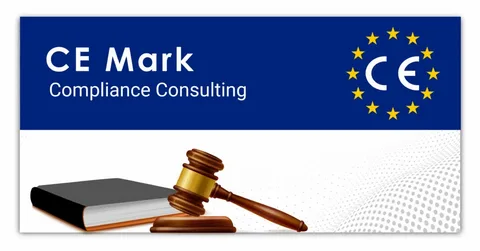Your Passport to Europe: Understanding CE Marking Requirements

Table of Contents
- Introduction
- What is CE Marking?
- A Quick Definition
- What Does It Really Mean for Businesses?
- Why CE Marking Matters
- Access to the EU Market
- Boosting Consumer Confidence
- Products That Require CE Marking
- Key Categories
- Not Sure If Your Product Qualifies?
- Step-by-Step: The CE Marking Process
- Step 1: Identify Applicable Directives and Standards
- Step 2: Perform Conformity Assessment
- Step 3: Prepare the Technical Documentation
- Step 4: Make a Declaration of Conformity
- Step 5: Affix the CE Mark
- Common Challenges and How to Overcome Them
- Navigating Complex Directives
- Documentation Pitfalls
- CE Marking vs ISO Certification
- What’s the Difference?
- Can They Work Together?
- How CE Marking Aligns with Other Certification Needs
- Choosing the Right Support: Certification Services
- ISO Certification Services in UK
- Services for Small Businesses
- Final Thoughts
- FAQs
Introduction
If you’re aiming to sell products in Europe, you need more than just a killer product. You need CE marking—your official passport to the European Economic Area (EEA). It’s not just about putting a logo on your label; it’s about proving your product meets health, safety, and environmental protection standards.
Let’s decode the CE marking process so you can expand your business with confidence and credibility.
What is CE Marking?
A Quick Definition
CE marking stands for “Conformité Européenne,” meaning “European Conformity.” It’s a mandatory mark on many products sold within the EU and EEA. When a product has a CE mark, it means the manufacturer guarantees the product meets relevant EU legislation.
What Does It Really Mean for Businesses?
It means you’re allowed to sell your products in the EU without facing additional barriers. But more than that, it means your product is compliant, safe, and aligned with EU expectations—a major competitive advantage.
Why CE Marking Matters
Access to the EU Market
You can’t legally sell most electrical, medical, or machinery products in Europe without a CE mark. That means no CE mark, no market access.
Boosting Consumer Confidence
European consumers are savvy. They look for the CE mark because it signals safety and compliance. It builds trust before they even open the box.
Products That Require CE Marking
Key Categories
| Category | Examples |
|---|---|
| Electrical equipment | Computers, TVs, kitchen appliances |
| Machinery | Industrial tools, power equipment |
| Medical devices | Thermometers, surgical equipment |
| Construction products | Windows, cement, fire alarms |
| Toys | Children’s games, dolls |
| Personal protective equipment | Helmets, gloves, safety eyewear |
Not Sure If Your Product Qualifies?
When in doubt, consult a CE marking expert or look through the official EU directives. Don’t assume—a mistake can delay your market entry.
Step-by-Step: The CE Marking Process
Step 1: Identify Applicable Directives and Standards
The EU has specific directives for different product types. You must determine which ones apply to your product. Examples:
- Low Voltage Directive for electronics
- Medical Devices Regulation for healthcare items
Step 2: Perform Conformity Assessment
Depending on your product and its risk level, you may need:
- Self-assessment
- Third-party testing by a Notified Body
Step 3: Prepare the Technical Documentation
You must compile evidence proving your product complies with the directives. This includes:
- Product specs
- Risk analysis
- Test results
- Design and manufacturing data
Step 4: Make a Declaration of Conformity
You sign a legal statement declaring that your product meets all relevant EU requirements. Keep this on file!
Step 5: Affix the CE Mark
Once all is complete, attach the CE mark visibly and permanently to your product. Congrats—you’re ready to sell!
Common Challenges and How to Overcome Them
Navigating Complex Directives
EU directives can be dense and confusing. The solution? Work with experts in ISO certification services in the UK who also offer CE marking guidance.
Documentation Pitfalls
Your product might be safe, but if your paperwork isn’t, your CE application can be rejected. Organize, document, and store everything securely.
CE Marking vs ISO Certification
What’s the Difference?
CE marking is a regulatory requirement for market access. ISO certifications like ISO 9001, ISO 14001, or ISO 27001 certification UK are voluntary but show excellence in quality, environment, and data security.
Can They Work Together?
Absolutely. ISO certifications support CE marking by improving processes, documentation, and compliance. Think of ISO as your internal improvement tool and CE as your external compliance badge.
How CE Marking Aligns with Other Certification Needs
| Certification Type | Main Benefit |
| ISO 9001 Certification UK | Quality management and continuous improvement |
| ISO 14001 Certification UK | Environmental care and sustainability |
| ISO 27001 Certification UK | Data security compliance and risk management |
| ISO 45001 Certification | Occupational risk management and workplace safety standards |
| ISO 22000 Certification | Food industry ISO certification and hygiene assurance |
| ISO 13485 Certification | Device safety and performance in the medical sector |
| ISO 22301 Certification | Disaster recovery planning and operational resilience |
| EMS Certification | Environmental responsibility and sustainable energy practices |
Second table heading bolded above ✔
Choosing the Right Support: Certification Services
ISO Certification Services in UK
From CE marking to full ISO certification packages, the right partner makes all the difference. Look for providers with:
- UKAS accreditation
- Industry-specific expertise
- End-to-end consultancy
Services for Small Businesses
You don’t need to be a corporate giant to meet CE marking requirements. Many services offer ISO certification services for small businesses UK, complete with:
- Cost-effective plans
- Remote audits
- One-on-one expert support
Final Thoughts
CE marking isn’t a nice-to-have—it’s a must-have if you plan to sell in Europe. But it’s not just about legality. It’s a powerful signal of trust, quality, and responsibility.
With the right guidance, clear documentation, and maybe a little help from your ISO-certified friends, you can navigate CE marking like a pro.
FAQs
1. Is CE marking required for all products in the UK and EU?
No. Only products covered by specific EU directives require CE marking. Always check the latest regulations.
2. Can I self-certify my product for CE marking?
In many cases, yes—but only if your product is considered low-risk. Otherwise, you’ll need a Notified Body.
3. How long does the CE marking process take?
It can take anywhere from a few weeks to several months depending on your product complexity and readiness.
4. Does Brexit affect CE marking in the UK?
Yes. Post-Brexit, UKCA marking is required for products sold in Great Britain, but CE is still accepted in Northern Ireland and the EU.
5. What happens if I sell a product without CE marking?
You could face penalties, product recalls, or legal action. Always ensure compliance before launching your product.
Sponsored article: HF 27 – High-Flotation Tyre for Enhanced Performance in Agricultural and Industrial Applications



